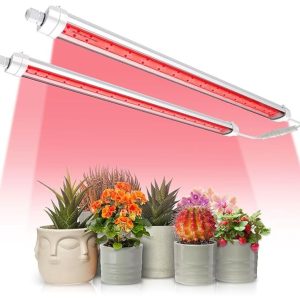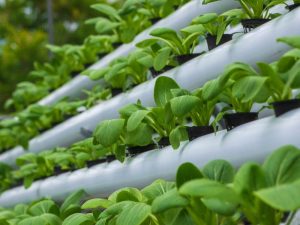A strawberry tower offers a space-saving and efficient way to grow fresh, juicy strawberries home. These vertical planters are perfect for small gardens, patios, or indoor spaces, making them an excellent solution for urban gardening enthusiasts. With the right strawberry tower grow kit, you can simplify assembly and ensure a productive harvest season after season. From stackable designs to hydroponic systems, plenty of options are available to suit every gardener’s needs.
Here’s a guide to help you choose the best strawberry tower and maximize your growing success.
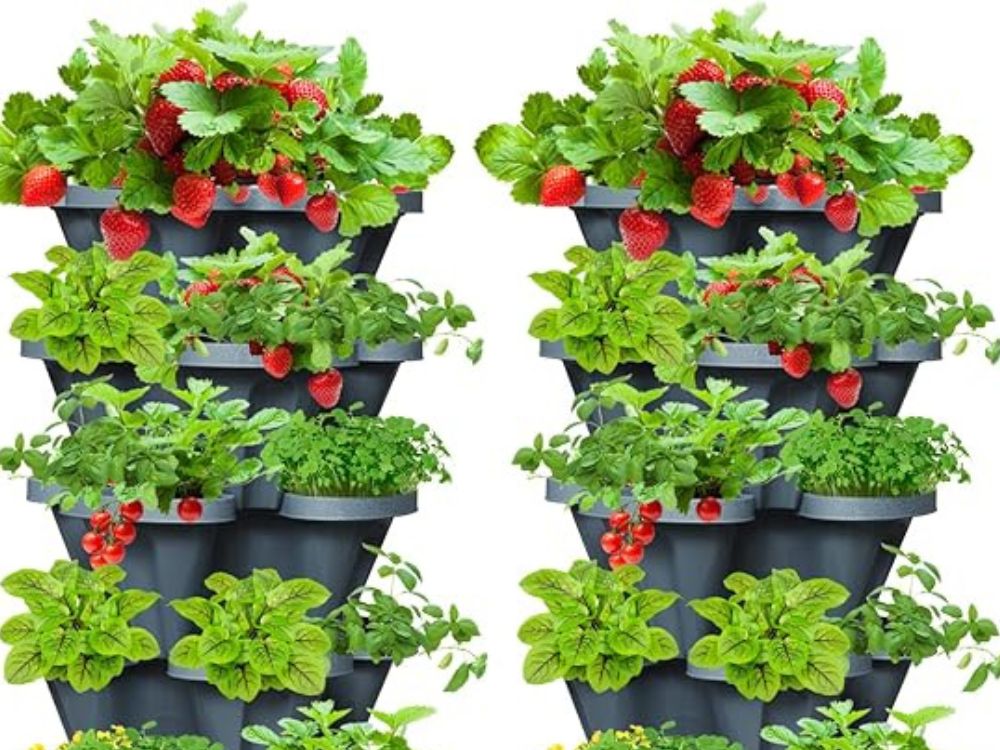
Top 5 Strawberry Tower Grow Kits
Contents
Growing strawberries at home has never been easier with strawberry tower grow kits. These space-saving vertical planters make gardening accessible to everyone, even in the smallest spaces. Whether you’re looking for a simple stackable design or an advanced hydroponic system, there’s a grow kit tailored to your needs. Below, we’ve highlighted the top five strawberry tower grow kits to help you get started.
Mr. Stacky 5-Tier Strawberry Planter Pot
The Mr. Stacky 5-Tier Strawberry Planter Pot is a gardener favorite for its simple and efficient design. This stackable planter allows you to grow up to 20 strawberry plants in just a few square feet. The flow-through system prevents overwatering and promotes healthy root development. Its durable material is ideal for outdoor and indoor use, ensuring year-round gardening opportunities.
VIVOSUN 5-Tier Vertical Gardening Stackable Planter
The VIVOSUN 5-Tier Vertical Gardening Planter is perfect for strawberries, herbs, and flowers. With its sturdy, stackable tiers, this kit offers functionality and style. It’s lightweight, easy to assemble, and suitable for balconies, patios, or gardens. The built-in drainage system keeps plants healthy and minimizes maintenance. This planter is a great choice for beginners and experienced gardeners alike.
Hydroponics Tower Garden Growing System Kit
The Hydroponics Tower Garden System is a top-tier option for those interested in hydroponic gardening. This kit features a 30-pod system and LED grow lights, making it ideal for indoor use. It’s equipped with a water pump for consistent irrigation and nutrient delivery. Grow strawberries, herbs, and vegetables easily in this self-sustaining, efficient setup. It’s a fantastic way to bring modern gardening into your home.
5-Tier Stackable Strawberry Garden
The 5-Tier Stackable Strawberry Garden blends a neat appearance with usefulness. While the attached drip saucer guarantees correct water distribution, each layer offers enough area for growing strawberries and other crops. Gardeners of all ability will find this lightweight and simple to set-up equipment appropriate. Its adaptable design offers small-scale gardening a great fit for kitchens, balconies, or outdoor areas.
Tectsia Strawberry Vertical Planters Tower Garden
The Tectsia Strawberry Vertical Planter offers a seven-tier system for growing strawberries, herbs, and vegetables. Its compact, stackable design maximizes space while maintaining a sturdy structure. This kit also comes with a support pole to ensure stability during growth. It’s ideal for both indoor and outdoor use, making it a versatile choice for any gardening enthusiast. The thoughtful design simplifies planting and harvesting, making it a great addition to your gardening tools.
Benefits of Using a Strawberry Tower
Growing strawberries right at home can be rather fulfilling. Still, classic gardening techniques sometimes call for plenty of space and careful design. Modern solutions abound from strawberry towers, which save space, boost yields, and simplify maintenance. Here, we discuss the main advantages of growing your preferred fruit from a strawberry tower.
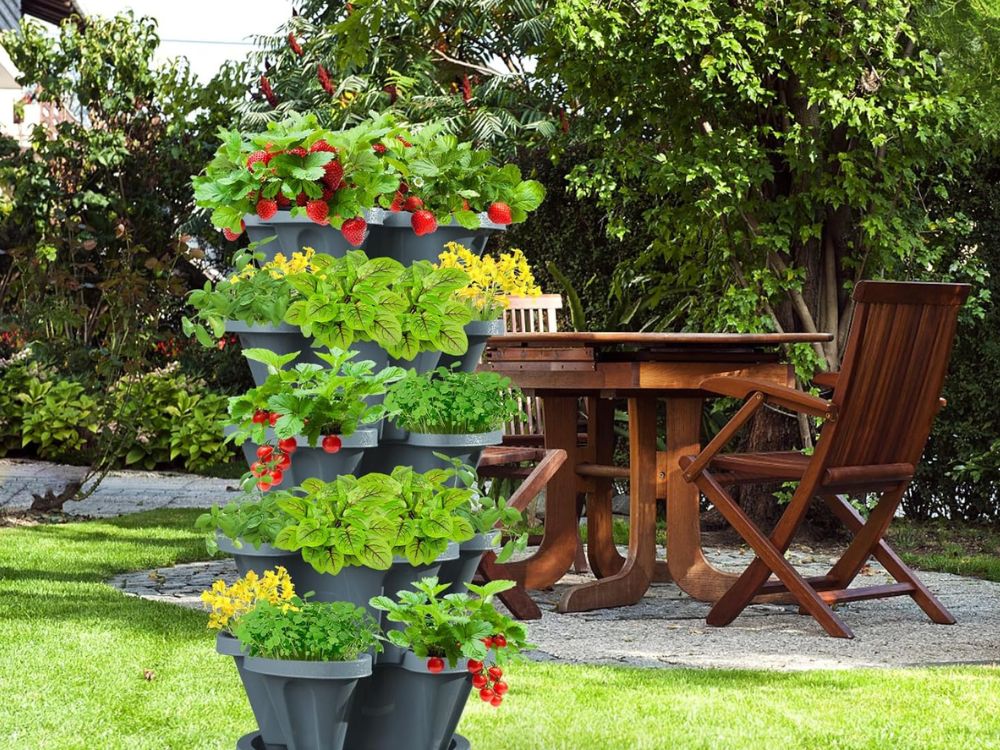
Space-Saving Design
The vertical architecture of a strawberry tower offers one of its main benefits. Unlike conventional garden beds that cover a lot of territory, these towers let you grow several plants in a small footprint. This makes urban gardeners or those with little outside areas perfect. A 5-tier strawberry tower, for instance, can accommodate up to 20 plants in a space of as little as a few square feet. Whether you have a tiny garden or live in an apartment, a strawberry tower lets you produce plenty without sacrificing space.
The stacked layers also ensure that every plant has adequate space to flourish and is free from nutritional competition. Gardeners wishing to raise strawberries alongside other plants like herbs, flowers, or vegetables will find this effective use of space extremely helpful. You can create a useful garden from the smallest space with a strawberry tower.
Improved Airflow and Sunlight Access
Strawberry towers are designed to promote better airflow and sunlight exposure for each plant. In traditional ground gardening, plants often grow close together, which can lead to overcrowding. Poor airflow increases the risk of fungal diseases and pest infestations. The vertical arrangement of a strawberry tower eliminates these issues by spacing the plants evenly across multiple tiers.
This improved airflow helps keep the plants dry and reduces the likelihood of rot or mildew. Additionally, the tiered design ensures that every plant gets equal access to sunlight. In a horizontal garden, some plants can be shaded by others, limiting their growth. Each tier receives optimal light with a strawberry tower, resulting in healthier plants and higher yields. This feature makes strawberry towers especially effective for sunny patios or gardens with limited direct sunlight.
Easy Maintenance and Harvesting
Traditional gardening can involve a lot of bending, kneeling, and digging, which can not be practical for everyone. Strawberry towers make gardening more accessible by reducing the physical strain of planting and harvesting. Since the plants are elevated, you can water, prune, and harvest them without bending down repeatedly.
This convenience is particularly beneficial for older gardeners or individuals with mobility issues. The tower’s organized structure also makes it easier to spot ripe strawberries, ensuring that none go to waste. Additionally, the controlled layout simplifies tasks like weeding and pest control, as the compact design minimizes the areas where weeds can grow or pests can hide. For busy gardeners, this means less time spent on maintenance and more time enjoying the fruits of their labor.
Efficient Watering System
Many strawberry towers have built-in watering systems that make irrigation more efficient. These systems often include a central watering tube or flow-through design that evenly distributes water across all tiers. This eliminates the risk of overwatering or underwatering, common issues in traditional gardening.
The efficient watering system also conserves water by directing it exactly where it’s needed. Excess water drains away, preventing root rot and other water-related problems. Some towers even allow you to collect and reuse the drained water, making them an eco-friendly option. By using a strawberry tower, you can ensure that your plants stay hydrated while reducing water waste.
Protection Against Pests and Diseases
Strawberry plants grown on the ground are more susceptible to pests like slugs, snails, and ants, and diseases caused by soil contamination. A strawberry tower minimizes these risks by elevating the plants off the ground. This physical barrier makes it harder for crawling pests to reach the plants and reduces the need for chemical pesticides.
Furthermore, a strawberry tower’s improved airflow and drainage help prevent fungal diseases such as powdery mildew and gray mold. Keeping the plants dry and well-ventilated creates a healthier environment for growth. For gardeners looking to grow organic strawberries, this feature is particularly important, as it reduces the reliance on synthetic chemicals and promotes natural growing practices.
Versatility and Aesthetic Appeal
Strawberry towers are not only functional but also visually appealing. Their vertical structure adds a unique element to your garden, balcony, or patio. Many towers come in stylish designs and colors that complement your outdoor decor. Whether you prefer a rustic wooden tower or a sleek plastic model, you can find an option that suits your aesthetic preferences.
These towers can grow strawberries, herbs, flowers, and small vegetables, as well as various other plants. Their versatility makes them valuable additions to any gardening setup. By combining different plants, you can create a vibrant, multi-functional, practical, and beautiful garden.
Year-Round Gardening Opportunities
With the right setup, a strawberry tower allows you to grow strawberries year-round. For example, hydroponic systems and indoor towers with grow lights enable you to cultivate plants even during the colder months. This means you can enjoy fresh strawberries regardless of the season.
Year-round gardening also gives you more control over your plants’ environment. You can ensure consistent growth and production by regulating factors like temperature, light, and humidity. This makes strawberry towers an excellent choice for gardeners who want to extend their growing season or explore indoor gardening.

Eco-Friendly Gardening Solution
Strawberry towers are an environmentally friendly alternative to traditional gardening methods. Their compact design reduces the amount of soil, water, and fertilizer needed to grow healthy plants. Many models are made from recycled materials, further minimizing their environmental impact.
Additionally, by growing your own strawberries at home, you can reduce your reliance on store-bought produce, which often comes with a large carbon footprint. From transportation to packaging, commercially grown strawberries can have a significant environmental impact. A strawberry tower allows you to enjoy fresh, locally grown fruit while contributing to a more sustainable lifestyle.
A strawberry tower is a game-changer for anyone growing strawberries at home. Its space-saving design, improved airflow, and ease of maintenance make it a practical and efficient gardening solution. With benefits like efficient watering, pest protection, and year-round growing opportunities, strawberry towers are a must-have for urban gardeners and those with limited space. Whether you’re a beginner or an experienced gardener, investing in a strawberry tower will elevate your gardening experience and provide you with a bountiful harvest of fresh, delicious strawberries.
Tips for Growing Strawberries in a Strawberry Tower
Growing strawberries in a strawberry tower is an innovative and efficient way to cultivate fresh fruit in a compact space. However, you need the right techniques and attention to detail to achieve a thriving harvest. With proper preparation and care, your strawberry tower can yield healthy, delicious strawberries season after season. Here are some expert tips to help you get the most out of your strawberry tower gardening experience.
Choose the Right Strawberry Variety
Not all strawberry varieties are suited for vertical gardening. When selecting plants for your tower, consider everbearing or day-neutral varieties. These strawberries produce fruit continuously throughout the growing season, making them ideal for small-space gardening. Popular options include Albion, Seascape, and Quinault strawberries, known for their consistent yields and robust growth.
Avoid June-bearing varieties, as they produce fruit only once per season and can not maximize your tower’s potential. Research the specific requirements of your chosen variety to ensure they align with your local climate and growing conditions.
Use High-Quality Soil and Fertilizer
The soil you use plays a significant role in the success of your strawberry tower. Choose a well-draining, nutrient-rich potting mix to promote healthy root development. Adding organic matter, such as compost or aged manure, can improve soil fertility and structure. Avoid using garden soil, which can compact over time and hinder root growth.
Strawberries are heavy feeders, so supplement the soil with a balanced fertilizer. Opt for a slow-release fertilizer or a liquid feed rich in nitrogen, phosphorus, and potassium. Fertilize your plants every 4-6 weeks during the growing season to ensure they receive the nutrients they need for vigorous growth and fruit production.
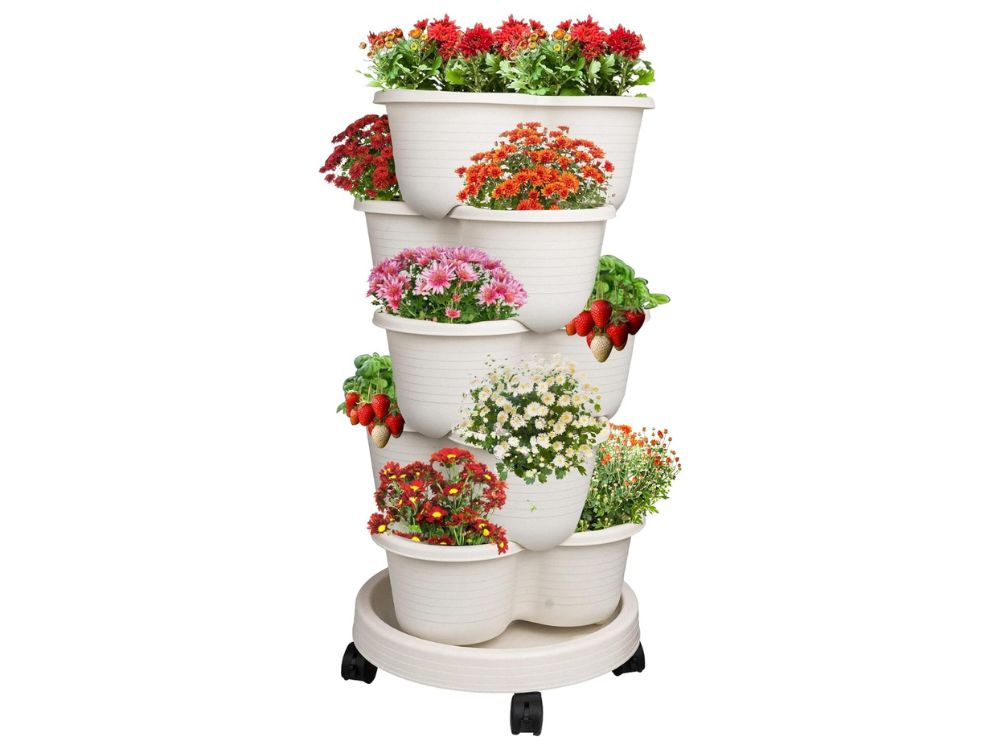
Plant Strategically for Maximum Yield
Proper planting is essential to make the most of your strawberry tower. When planting, ensure that the crown of each strawberry plant is level with the soil surface. Planting too deeply can cause the crown to rot, while planting too shallowly can expose the roots, leading to dehydration.
Space the plants evenly within each tier to prevent overcrowding. Overcrowded plants compete for sunlight, water, and nutrients, reducing yields. Giving each plant adequate room to grow’ll encourage healthier plants and more abundant fruit.
Water Consistently and Efficiently
Strawberries in a tower require consistent watering, as the vertical structure can cause the soil to dry out faster than in traditional garden beds. Water your tower regularly, ensuring that the soil remains moist but not waterlogged. Most strawberry towers have a built-in drainage system to prevent overwatering, but monitoring soil moisture levels is still important.
Drip irrigation systems or a watering wand can make watering more efficient, especially for taller towers. Water early in the morning to allow excess moisture to evaporate, reducing the risk of fungal diseases. You can need to water more frequently during hot or dry periods to keep the plants hydrated.
Provide Adequate Sunlight
Strawberries are sun-loving plants requiring at least 6-8 hours of direct sunlight daily. Place your strawberry tower in a location with plenty of sunlight, such as a south-facing patio or garden area. If growing strawberries indoors, use grow lights to provide the necessary light for healthy growth and fruiting.
Rotating your tower periodically can help ensure that all sides receive equal sunlight exposure. This is especially important for larger towers, where the lower tiers can be shaded by the upper levels. Adequate sunlight promotes robust growth and maximizes fruit production.
Mulch to Retain Moisture and Control Weeds
Mulching is a simple yet effective way to retain soil moisture and prevent weed growth in your strawberry tower. Use organic mulch materials like straw, pine needles, or shredded bark to cover the soil surface around each plant. Mulch also helps regulate soil temperature, keeping the roots cool during hot weather and warm during cooler months.
In addition to conserving moisture, mulch creates a barrier that minimizes soil splashing, reducing the risk of soil-borne diseases. Replenish the mulch to maintain an even layer throughout the growing season.
Prune and Train Your Plants
Regular pruning is essential to keep your strawberry plants healthy and productive. Remove any yellowing or damaged leaves to prevent spreading diseases and pests. Additionally, trim off runners (stolons) if you’re growing strawberries primarily for fruit production. Runners divert energy away from fruiting, so removing them helps the plant focus on producing berries.
If you want to propagate new plants, allow a few runners to develop roots in separate pots. Once established, you can transplant these young plants into your strawberry tower or another garden space.

Protect Against Pests and Diseases
Aphids, snails, and spider mites are just some pests that could afflict strawberry plants. Look over your plants often for indicators of an infestation, such as sticky residue or leaf holes. Use natural pest control techniques such as neem oil or introducing helpful insects (ladybugs and lacewings).
Space the plants correctly and avoid overhead watering to guarantee optimum airflow between them, preventing fungal infections. Get any sick leaves out right once to stop the illness from spreading. Reducing insect and disease issues mostly depends on keeping your tower neat and well-maintained.
Prepare for Winter
You must protect your strawberry tower during the dormant season if you reside in an area with frigid winters. To protect the tower from strong winds, move it to a protected spot, say a garage or shed. To further insulate the tower, wrap it with burlap or frost cloth.
Water just lightly in winter, as the plants need less moisture when dormant. To prepare for the growth season, cut away dead leaves and replenish the ground with compost or fertilizer early in spring.
Growing strawberries in a strawberry tower is one fulfilling and quick approach to eating fresh fruit right at home. Selecting the correct variety, giving your tower the correct care, and using this professional advice will help you optimize the output of your tower and guarantee a plentiful crop. With a little work and attention, your strawberry tower will grow to be a vibrant focal point of your indoor, patio, or garden.
Conclusion
Growing strawberries in a strawberry tower is a rewarding and efficient way to enjoy fresh fruit at home. You can maximize your tower’s productivity and ensure a bountiful harvest by choosing the right variety, providing proper care, and following these expert tips. With a little attention and effort, your strawberry tower will become a thriving centerpiece of your garden, patio, or indoor space.
We have more ways to grow plants in limited spaces. Check out our vertical planters guide next!



